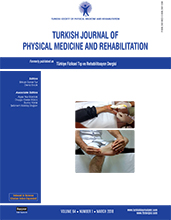Low back pain in hemodialysis patients: Risk factors and its impact on health-related quality of life
2 Department of Nephrology, Dışkapı Yıldırım Beyazıt Training and Research Hospital, Ankara, Turkey DOI : 10.5606/tftrd.2018.1016 Objectives: The aim of this study was to evaluate frequency and characteristics of low back pain and to identify possible risk factors of low back pain and its impact on health-related quality of life in hemodialysis patients.
Patients and methods: A total of 87 hemodialysis patients (41 males, 46 females; mean age: 53.3±15.8 years; range, 21 to 80 years) were included in the study between January 2015 and July 2015. Medical charts and face-to-face interviews were used to collect clinical and demographic data. A comprehensive clinical evaluation of low back pain was implemented. The patients were divided into two groups: those with (n=32) and without (n=55) low back pain. Demographic data, quality of life, pain, and disability were compared between the groups. Pain severity was assessed using the Visual Analog Scale (VAS). Low back pain-associated disability was measured using the Oswestry Disability Index (ODI). Risk factors of low back pain were identified using multiple logistic regression analysis. The impact of low back pain on health-related quality of life was measured using the Nottingham Health Profile (NHP).
Results: Advanced age, increased body mass index, and smoking were found to be significant independent risk factors of low back pain (p=0.048; p=0.037; p=0.020, respectively). Energy, pain, and physical mobility subscale scores of the NHP were also higher in the hemodialysis patients with low back pain (p=0.008; p<0.001; p<0.001, respectively). Energy, pain, sleep, and physical mobility subscale scores of the NHP showed a significant positive correlation with the ODI scores (r=0.424, p=0.016; r=0.803, p<0.001; r=0.493, p=0.004; r=0.862, p<0.001, respectively). The etiology of low back pain was non-specific in the majority of the patients (71.9%). There were spondylodiscitis in two patients (6.2%), compression fractures in two patients (6.2%), spinal stenosis in one patient (3.1%), and discopathy in four patients (12.5%).
Conclusion: Low back pain is a common condition in hemodialysis patients. Advanced age, increased body mass index, and smoking are the main risk factors of low back pain. The presence of low back pain is also related to poor health-related quality of life in hemodialysis patients.
Keywords : Hemodialysis; low back pain; quality of life

















